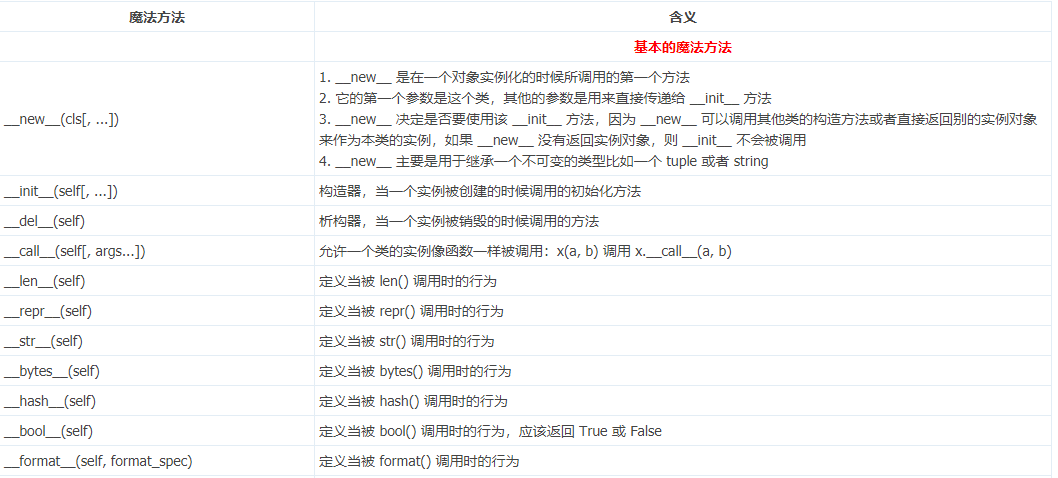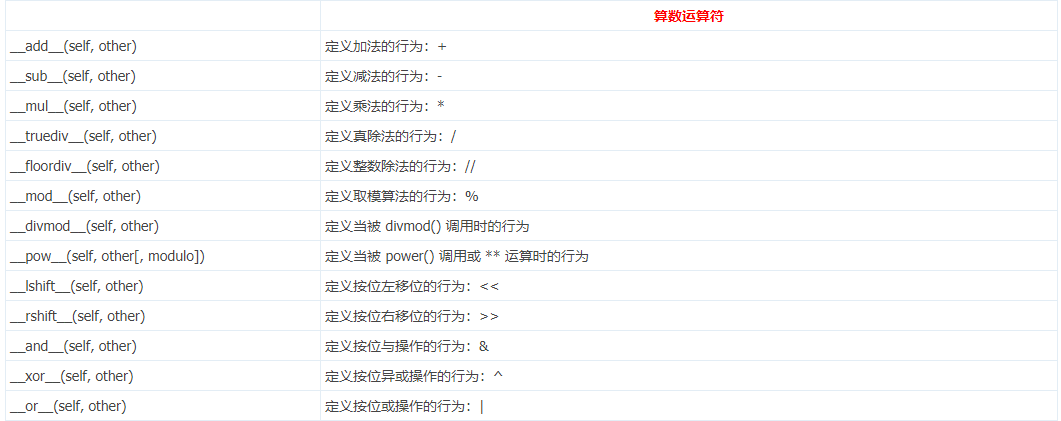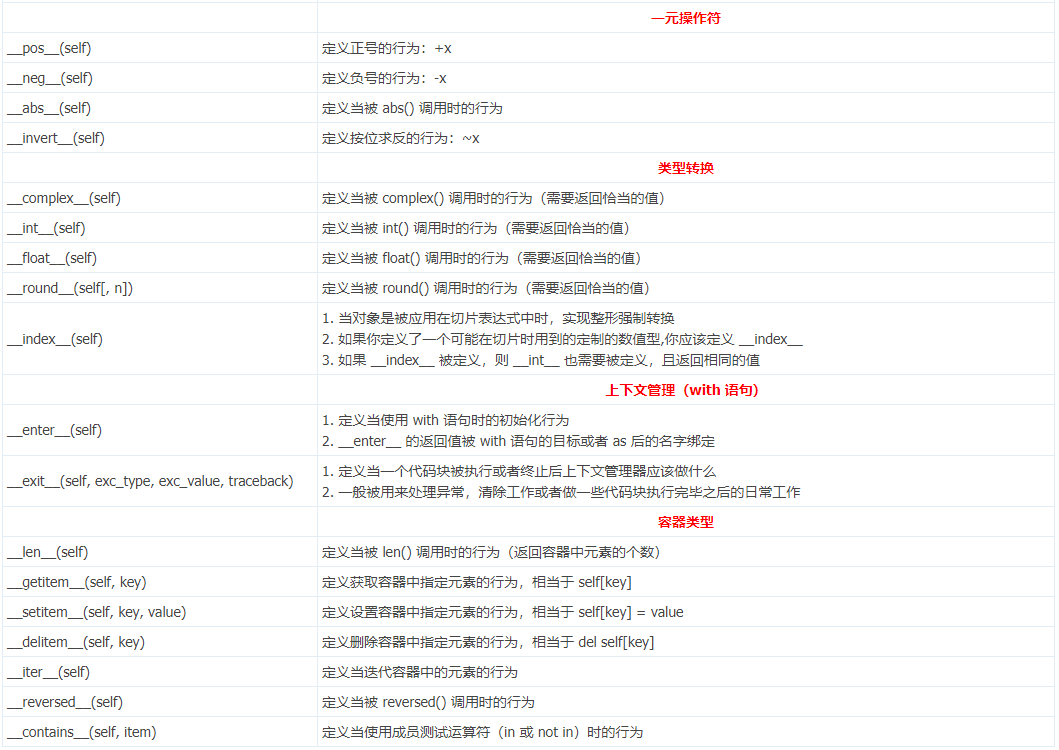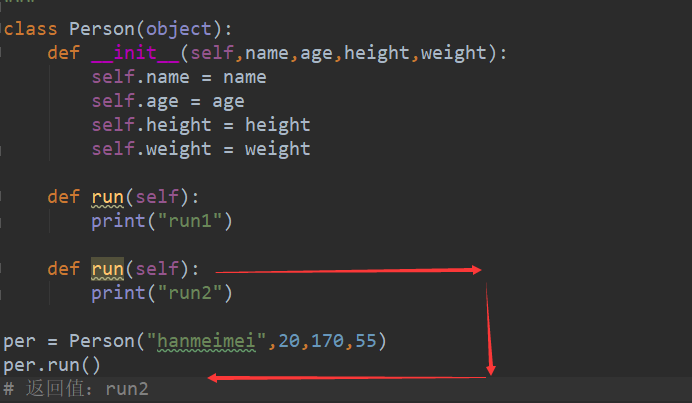Python笔记_第三篇_面向对象_3.重载(overloading)和重写(overriding)
1. 重载:
overloading:就是将函数重新定义一遍。
1.1 __str__( )和__repr__( )的重载:
格式:
__str__( ):在调用print打印对象时自动调用,是给用户用的,是一个描述对象的方法。
__repr__( ):给机器用的,在Python解释器或者在cmd的黑屏终端里面输入,注意在没有str时,且有repr,str = repr,其实本事就是打印类本身想要实现的属性。
举例说明1:
class Person(object): def __init__(self,name,age,height,weight): self.name = name self.age = age self.height = height self.weight = weight def __str__(self): # return "这里是__str__" return "%s-%d-%d-%d" %(self.name,self.age,self.height,self.weight) # def __repr__(self): # # return "这里是__str__" # return "%s-%d-%d-%d" %(self.name,self.age,self.height,self.weight) per = Person("hanmeimei",20,170,55) print(per) print(per.__str__()) # 其实不写入类体重,这里也是可以直接打印的。 # hanmeimei-20-170-55 # hanmeimei-20-170-55
优点:当一个对象的属性值很多的时候,兵器都需要打印,重写__str__方法后,简化了代码。
1.2 __add__( ) 的重载
比如我们有这么两个运算
print(1 + 2)
print("1" + "2")
我们知道,返回的结果一个是3,一个是12。前面是一个int类型的数值,后面是一个字符串。也就是说,不同类型的加法会有不同给的解释。
因此我们在类中重新定义一个加法的重载。
格式:
__add__(self,other):sef代表加号前面的对象,other表示加法后面的对象。
举例说明2:
class Person(object): def __init__(self,num): self.num = num # 运算符重载 def __add__(self, other): #self 代表加号前面的对象,other表示加法后面的对象 return Person(self.num + other.num) def __str__(self): return "num = " + str(self.num) per1 = Person(1) per2 = Person(2) print(per1 + per2) print(per1.__add__(per2)) # num = 3
1.3 其他重载:
Python当中的重载也不算很多,我下面列举了一个小表格,对Python的重载进行罗列
在很多教材中:重载也叫Python的魔法方法。






小贴士:
help和dir
help可以查询相关的内容解释,dir可以查看目录内的内容。
help("__add__()") # 用help去查找帮助内容: # No Python documentation found for '__add__()'. # Use help() to get the interactive help utility. # Use help(str) for help on the str class. class Person(object): def __init__(self,name): self.name = name per = Person("Tom") print(dir(per)) # 现实类相关的内容 # ['__class__', '__delattr__', '__dict__', '__dir__', '__doc__', '__eq__', # '__format__', '__ge__', '__getattribute__', '__gt__', '__hash__', '__init__', # '__init_subclass__', '__le__', '__lt__', '__module__', '__ne__', '__new__', # '__reduce__', '__reduce_ex__', '__repr__', '__setattr__', '__sizeof__', # '__str__', '__subclasshook__', '__weakref__', 'name']
2. 重写:
overriding:就是一个类当中可以有一个以上的方法具有相同名称。

举例说明1:
class Person(object): def __init__(self,name,age,height,weight): self.name = name self.age = age self.height = height self.weight = weight def run(self): print("run1") def run(self): print("run2") per = Person("hanmeimei",20,170,55) per.run() # 返回值:run2
其实我们发现Python并不需要重载。在C#语言中,重载时两个相同的函数名,且参数类型不一样,类似于:
run(int b)
run(long b)
这种函数时重载的现象。但是python里面的重载其实就是识别最后一个函数的意思。
举例说明2:我们在通过一个类的继承来观察重写,在父类中有一个run方法,子类继承父类,也有一个相同的run方法。我们发现也是最后面那个重写的run2进行加载
class Person(object): def __init__(self,name,age,height,weight): self.name = name self.age = age self.height = height self.weight = weight def run(self): print("run1") class Worker(Person): def __init__(self,name,age,height,weight): super(Worker,self).__init__(name,age,height,weight) def run(self): print("run2") per = Person("hanmeimei",20,170,55) wor = Worker("Tom",20,170,60) wor.run() # 返回值:run2
本博客所有文章仅用于学习、研究和交流目的,欢迎非商业性质转载。






